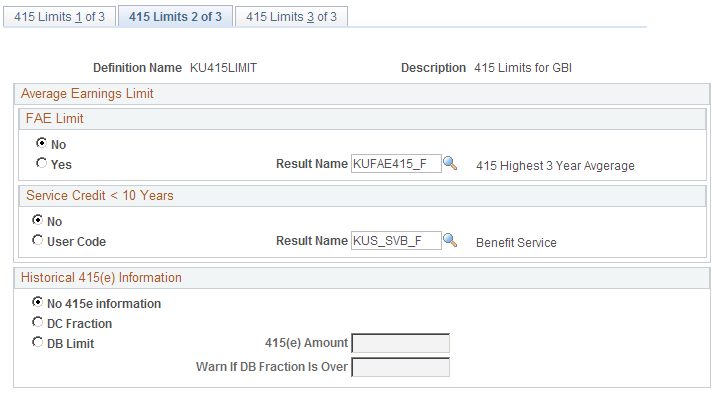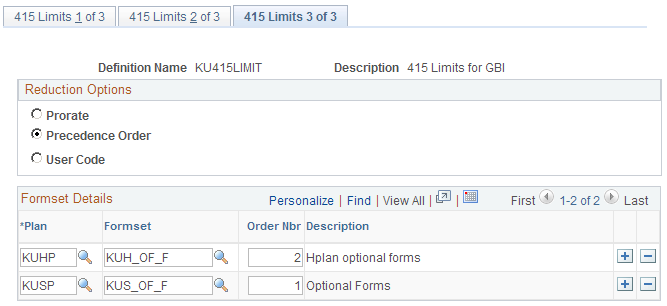Creating a 415 Limits Definition
To define a 415 limits definition, use the 415 Limits Parameters (415_LIMITS) component.
|
Page Name |
Definition Name |
Usage |
|---|---|---|
|
PA_415_PNL |
|
|
|
PA_415_PNL2 |
|
|
|
PA_415_PNL3 |
Establish the method for reducing the total benefit. |
Use the 415 Limits 1 of 3 page (PA_415_PNL) to:
Define the 415(b) maximum dollar limit.
Set up the normal limit and conditions for increasing or reducing that limit.
Navigation:
This example illustrates the fields and controls on the 415 Limits 1 of 3 page.

Processing Parameters
The system uses the table lookup utility to find the 415(b) dollar limit for the event year.
Field or Control |
Description |
|---|---|
415 Limit Table Lookup |
Enter the table lookup for the 415 Limit table. The table lookup you create should:
|
Actuarial Decrease Prior to Age 62
When an employee begins receiving benefits before age 62, there is an actuarial reduction.
Note: Even if you sponsor multiple qualified plans, you can only enter a single plan reduction factor. This is the same for the plan increase factor and the participation service function result.
Field or Control |
Description |
|---|---|
Plan Reduction Factor and GATT Reduction Factor |
Specify both factors. The system uses the lesser of the two, thus providing the greater reduction. The factors are results from the early and late retirement factors function. Remember that early and late adjustments can produce actuarial factors, in addition to the arithmetic factors typically used for early retirement reductions. You may need to create early and late retirement factors function results specifically for 415, or you may be able to reuse one from one of your plans. To set up the GATT or GAR94 adjustments, create an early and late retirement factors function result that uses GATT-compliant or GAR94 actuarial assumptions. |
Actuarial Increase After Age 65
Field or Control |
Description |
|---|---|
Plan Increase Factor and GATT Increase Factor |
Specify both factors. The system uses the lesser of the two, thus providing the smaller increase. You may need to create one specifically for 415, or you may be able to reuse one from one of your plans. To set up the GATT adjustment, create an early and late retirement factors function result that uses GATT-compliant actuarial assumptions. Note: The same fields are used for late retirement limit increase calculations that use pre-EGTRRA methodology. |
Decrease for Less Than 10 Years Participation
You may further reduce the 415 dollar limit when an employee has less than 10 years of participation service across all plans.
Field or Control |
Description |
|---|---|
Participation Service |
Enter a service function result representing the accrued participation service (you may need to create one just for your 415 calculations), or enter a user code. |
When participation is less than 10 years, the system reduces the limit using a factor found by dividing the years of participation service by 10. For example, an employee with 6.5 years of participation service is subject to a limit reduction of 65 percent.
Use the 415 Limits 2 of 3 page (PA_415_PNL2) to:
Define the 415(b) average earnings limit for defined benefit plans.
Define the historical 415(e) limits for combined defined benefit and defined contribution plans.
Navigation:
This example illustrates the fields and controls on the 415 Limits 2 of 3 page.

FAE Limit (final average earnings limit)
Use this group box to find the 415 average earnings limit.
Field or Control |
Description |
|---|---|
Result Name |
Enter a final average earnings function result to find the 415 average earnings limit. Do not be misled by the word final. Set up the definition to meet the "high three" criteria required by section 415, or you can enter a user code. |
See Understanding Final Average Earnings.
The 415 limits are subject to a minimum of 10,000 USD for employees who have never participated in a defined contribution (DC) plan. The 415 limits function automatically applies this rule. If this minimum should not be applied for an employee, enter historical 415(e) information on this page, and enter historical 415(e) data for the employee on the 415(e) Limit page. 415(e) limits are processed only where historically appropriate.
Service Credit < 10 Years
The system further reduces the 415 average earnings limit (after applying the 10,000 USD minimum) when an employee has less than 10 years of credited service across plans This service may or may not be measured the same way as the participation service used to adjust the dollar limit.
Field or Control |
Description |
|---|---|
Result Name |
Enter a service function result representing the accrued service. Note that the service credit is not necessarily the same as the participation service used to adjust the maximum dollar limit. Even if you sponsor multiple qualified plans, you can only enter a single service result name, so you may need to create one just for your 415 calculations. You can also enter a user code to determine service credit. |
When service credit is less than 10 years, the system then reduces the limit using a factor found by dividing the years of service by 10. For example, an employee with 6.5 years of participation service is subject to a limit reduction of 65 percent.
Understanding the Historical 415(e) Calculation
Prior to its elimination by SBJPA, Section 415(e) limited the combined benefit from defined benefit (DB) and defined contribution (DC) plans. Pension Administration can calculate this historical pre-SBJPA limit when the benefit commencement date of a calculation occurs in a plan year that ends before December 31, 2000. This calculation applies only when the DC plan is primary so that benefits in excess of the limit result in a reduction to the DB plan.
The reduction is determined either by a dollar limit on the total benefit (DC + DB) or by using a "DC fraction" to calculate the upper limit on the DB benefit. The DC fraction represents the portion of the total limited benefit expected to consist of the DC benefit. Since SBJPA removed the 415(e) limit, the dollar limit and fraction are referred to here as "historical."
Because the system does not have access to DC information, your plan administrator will have to provide it. On the 415(e) Limit page, the administrator can enter either the historical DC fraction or an already-calculated historical 415(e) limit for an individual employee.
Historical 415(e) Information
Use these parameters to tell the system where to find the historical DC fraction.
Field or Control |
Description |
|---|---|
No 415e information |
Select this option if you do not want the system to calculate historical 415(e) limits. |
DC Fraction |
Select this option if you store the historical DC fraction in the system. In the 415(e) Amount field, enter an alias to the field where the historical DC fraction is stored. If you use the 415(e) Limit page PeopleSoft provides, use the delivered alias DC_FRACTN. |
DB Limit |
Select this option if you store the precalculated limits, that is, the dollar amount of the historical 415(e) limit. In the Historical 415(e) Amount field, enter an alias to the field where this limit is stored. If you use the 415(e) Limit page that PeopleSoft provides, you use the delivered alias DB_LIMIT. |
Note: You select to always use the historical fraction or to always use the historical limit. Therefore, you should remove the unused field from the 415(e) Limit page to ensure that your users do not enter information that the 415 limits function does not recognize.
Field or Control |
Description |
|---|---|
Warn if DB Fraction Is Over |
Enter a threshold. Pension Administration calculates the DB fraction using the final, limited benefit. You can configure the system to notify you if the DB fraction exceeds a specified threshold. The warning appears in the calculation messages and on the calculation worksheet. |
Use the 415 Limits 3 of 3 page (PA_415_PNL3) to establish the method for reducing the total benefit.
Navigation:
This example illustrates the fields and controls on the 415 Limits 3 of 3 page.

When a benefit exceeds the 415 limit, you have to reduce the total benefit by reducing some or all of the component benefits.
Reduction Options
Field or Control |
Description |
|---|---|
Prorate |
Each benefit is reduced according to what portion of the unreduced benefit comes from that plan. For example, if a benefit has to be reduced by 10,000 USD, and Plan A supplied 50 percent of the unreduced benefit while Plans B and C each provided 25 percent of the unreduced benefit, then the Plan A benefit is reduced by 5,000 USD (50 percent of the 10,000 USD reduction) and the Plan B and C benefits are each reduced by 2,500 USD (25 percent of the 10,000 USD reduction). |
Precedence Order |
Select this option to assign a priority to each benefit. The first benefit is reduced first, any remaining reduction is subtracted from the second benefit, and so on until the entire reduction amount is applied. To assign a precedence order, you first list the benefits that might be reduced. You identify a benefit by plan and formset, the optional forms function result. |
User Code |
Select this option to use customized code. |
Formset Details
Field or Control |
Description |
|---|---|
Order Nbr (order number) |
The benefit with the first precedence number is reduced first. That is, a plan with precedence 1 is reduced before a plan with precedence 10. |